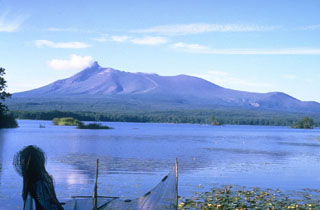Report on Hokkaido-Komagatake (Japan) — August 2000
Bulletin of the Global Volcanism Network, vol. 25, no. 8 (August 2000)
Managing Editor: Richard Wunderman.
Hokkaido-Komagatake (Japan) Small eruptions on 4 and 28 September, the first since October 1998
Please cite this report as:
Global Volcanism Program, 2000. Report on Hokkaido-Komagatake (Japan) (Wunderman, R., ed.). Bulletin of the Global Volcanism Network, 25:8. Smithsonian Institution. https://doi.org/10.5479/si.GVP.BGVN200008-285020
Hokkaido-Komagatake
Japan
42.063°N, 140.677°E; summit elev. 1131 m
All times are local (unless otherwise noted)
The last reported volcanic activity at Komaga-take was a small-scale phreatic eruption on 25 October 1998 (BGVN 23:09). After 1998 there were no reports of volcanism until September 2000 when small eruptions occurred on the 4th and 28th.
Komaga-take, about 120 km SW of the prefectural capital Sapporo, erupted at 2214 on 4 September. According to a Bernama news article, Hokkaido University Professor Hiromu Okada stated that he did not see any fresh cracks or crevices in the volcano when he observed it by helicopter the day after the eruption. He added that "there were many cinders popping out in a wide area ." The same day the Sapporo District Meteorological Observatory reported that a column of "smoke" rose up to 500 m above the volcano. According to the Bernama article, local authorities issued volcano warnings to the 60,000 residents of Mori, ~10 km NW of the volcano, and four other nearby towns. An Associated Press article reported that according to the observatory, a small amount of ash was observed on the ground in a town NW of the volcano. The Tokyo VAAC reported that no ash cloud was visible on GMS-5 imagery.
The volcano erupted for a second time on 28 September, but inclement weather inhibited observations. According to an Associated Press article, Hisao Hashimoto stated that a light coating of ash covered cars in a town at the base of the volcano. There were no reports of injuries or damage.
Geological Summary. Much of the truncated Hokkaido-Komagatake andesitic volcano on the Oshima Peninsula of southern Hokkaido is Pleistocene in age. The sharp-topped summit lies at the western side of a large breached crater that formed as a result of edifice collapse in 1640 CE. Hummocky debris avalanche material occurs at the base of the volcano on three sides. Two late-Pleistocene and two Holocene Plinian eruptions occurred prior to the first historical eruption in 1640, which began a period of more frequent explosive activity. The 1640 eruption, one of the largest in Japan during historical time, deposited ash as far away as central Honshu and produced a debris avalanche that reached the sea. The resulting tsunami caused 700 fatalities. Three Plinian eruptions have occurred since 1640; in 1694, 1856, and 1929.
Information Contacts: Tokyo VAAC (URL: http://ds.data.jma.go.jp/svd/vaac/data/); Bernama-dpa (URL: http://www.asiapac.net/bernama/prwire/); Associated Press (URL: http://www.ap.org/).

